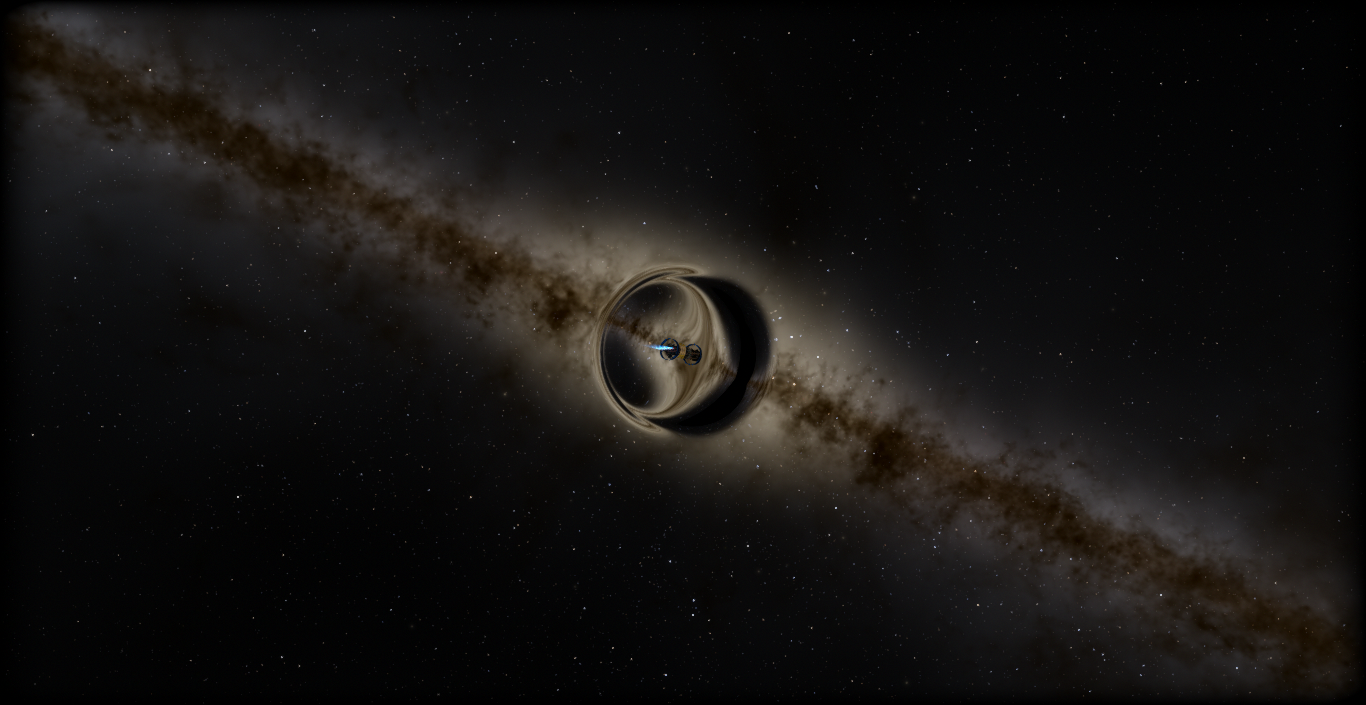Interstellar Navigation
Because of the extreme energy requirements of warp drives, warping large interstellar distances (in the case of Gen VI drives, >15 lightyears) is ill-advised and usually impossible due to fuel limitations. Thus, long journeys across known space (colloquially called "treks," or "hauls" in the case of cargo shipments) are performed in "jumps": a series of shorter warp-flights between station hubs to allow the vessel to refuel and stock up on supplies. A system's "jump links" are vectors to other systems within about ten lightyears. Though this is the safest method, further destinations require more jumps to reach and the longest routes (such as the one on the right) can take up to 9 months.
Finding the optimal interstellar vector utilizes a
simple asymptotic function involving three variables: the distance to the target in lightyears (
d), the warp amplification factor (
a), and the maximum real-space velocity of the object as a decimal value of the speed of light (
v). This function equates to the total flight duration in days (
T).
(707.646 • v) + ((d / (a • v)) • 365) = T
By plugging in specific values for
d and
a, and then deriving the function, its positive local minimum will be equivalent to the shortest possible travel time and ideal velocity for the given interstellar vector. For example: a modern Generation VI warp drive has a maximum amplification factor (
a) of about 4000, and the distance between Sol and Alpha Centauri (
d) is about 4.34 lightyears. Using these values in the formula results in an optimal velocity (
v) of about 0.0237
c, and a minimum travel time (
T) of ~33.5 metric days.
Drawbacks & Stipulations
Relative Velocity
Since warp drives amplify velocity in any direction, operators must ensure their velocity is absolutely aligned to their desired vector before engaging the drive; else they risk missing their destination or colliding with subluminal mass. This factor and its associated procedure are termed "warp relative velocity"; once WRV is within acceptable parameters it is safe to engage the drive. Course corrections must also be done in realspace, due to the effects of the bubble's event horizons on exhaust.
Bowshock
When in motion, the Alcubierre bubble collects cosmic radiation in the fore event horizon, which is immediately released as a focused shockwave upon the flattening of the bubble. This has been alleviated as a side effect of the magshield: an artificial magnetic field around the vessel primarily intended to protect the vessel from cosmic radiation, with the added bonus of trapping bowshock particles to gradually disperse them. Particle buildup is also lessened by the bubble transparency required by heat dumps.
Heat Dumping
The interior space of a warp bubble heats up very rapidly due to the confinement of the warpship's blackbody radiation by the event horizons of the bubble. To avoid the bubble's heat buildup reaching lethal levels, warpships have a sink complex to store waste heat during opaque phases of the flight. These heat sinks are periodically "dumped"; the vessel switches off the drive for a few minutes to allow the heat to be expelled into realspace through radiators and/or an open cycle cooling system.
Relativity Compliance
Under the laws of relativity, time flows differently under varying conditions of gravity and velocity. However, the only places in the universe where this difference is significant enough to be inconvenient are in the vicinity of extremely massive objects (black holes, neutron stars, etc) or from the reference frame of objects moving at significant fractions of light speed in real space. Therefore, it is generally accepted that the pace of time on any inhabitable body in the universe is functionally identical to that of any other inhabitable body, with the exception of starships travelling at significant fractions of light speed.
Warpships do not violate relativity by virtue of the fact that their transit occurs over a period of time, in combination with the aforementioned consensus that most non-relativistic reference frames in the universe are functionally identical. Thus, though anything
apparently travelling faster than light in a warp bubble may observe its own departure from its origin point, it cannot return to the origin before it left because it has still moved forward in the flow of time from every immediately actionable reference frame, and therefore has moved forward in the chain of causality.
Because a warpship never physically exceeds the speed of light, the relativistic effects of transit are dependent solely on the realspace velocity of the vessel (its hyperspace relative velocity, in a sense). The highest achievable time dilation factor is 0.866 (corresponding to a velocity of
0.5c), meaning that travellers may experience a time slip of up to five or six days behind the "universal now," on a particularly long journey. This is much better than the alternative of realspace relativistic travel, where timeslips of decades or more are a haunting reality.
Invention History
The slightly varying forms of warp drive were invented by each
sophont species independently, with the exception of
humans teaching the
Calypsians and
skae the principles of warp technology.
Shyxaure attained warpflight quite early on in their space age, a mere hundred years after first achieving orbit.
Ziirpu civilization recognized the practicality of warp drives well before entering space, thanks to the predictive technological progress simulations run by
Nzmarri, an advanced
artificial intelligence designed for exactly that purpose.
Curiously,
rimor did not achieve warp technology until nearly a thousand years into their spacefaring age, well after they had colonized their nearest systems. Even today, rimor warp technology is only slightly more advanced than that of their contemporaries, and much interstellar exploration mounted by the
Rimor Corporate Conglomerate still utilizes their unique pre-warp "rockhopper method" - flying much shorter, slower-than-light routes between rogue interstellar objects and making use of the resources there to power the next jump to another nearby unbound planetoid.
The foundation for the
human warp drive was laid in 1994 CE by Mexican theoretical physicist
Miguel Alcubierre, who proposed a method for changing the geometry of space by creating a wave that would cause the space ahead of a spacecraft to contract and the space behind it to expand. The ship would then ride this wave inside a region of flat space, known as a warp bubble, as the bubble is carried exactly in tandem with the vessel by the subluminal propulsion. After generations of extensive research and problem-solving, an engineering team spearheaded by Dr. Lindiwe Mbali built the first working full-scale prototype warp drive in 2246. After extensive autonomous and remote testing, the Generation I warp drive prototype was approved for human spaceflight, and flown by pilot Jesse Landis on June 15th, 2252. Captain Landis' 4.5-day, 54.6-million-kilometer flight from
Earth to
Mars made them the first human to travel within a warp bubble. Since then, the warp drive has undergone several improvements, notably the leap between generations III and IV from amplific factor W
100 to factor W
1000.
For additional information, see the Wikipedia page on Alcubierre drives.




That's an awesome take on FTL drive, great work combining both technical details and explanation on warp drives and relativity!
Thank you very much!! I've spent a loooong time figuring out how it all would realistically work and I'm happy to hear you enjoyed the results of that hard work! :)